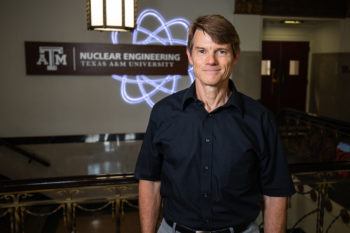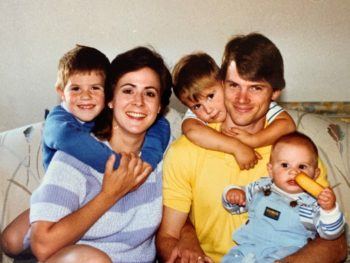Texas A&M Engineer Devotes Career To Nuclear Deterrence

Marvin L. Adams was nowhere to be found recently when President Joe Biden named him among 30 distinguished Americans who will serve on the President’s Council of Advisors on Science and Technology.
Nowhere to be found by the public, that is. Adams is a nuclear engineer at Texas A&M University who works on national security challenges — sometimes in secret locations.
That Wednesday, he said, he was “in a secure area where communication devices are not allowed.” Those who do classified work regularly call such places “behind the fence,” “the no-phone-zone” or “the cone of silence.”
That day, and throughout his career, Adams was working to help deter World War III.
The scientist plays a long game, one with the highest stakes imaginable. He has devoted a 35-year career of research, teaching and public service to ensure that the U.S. nuclear weapons stockpile remains a reliable deterrent to the nation’s adversaries.
When Adams earned his Ph.D. in 1986 from the University of Michigan, he considered different types of job offers before starting a career in the nuclear weapons program. The decision took some soul searching.
Adams said his conversation with himself went like this:
“Do you think you’ve benefited from nuclear deterrence?
“Yeah, I kind of do.
“If you think you have benefited, do you think you have any right to keep your hands clean?
“Or should you get in there and contribute?
“I probably should get in there and contribute.”
And so he did.
From a modest upbringing in rural Mississippi, Adams has become the nation’s foremost university-based expert on maintaining the nuclear stockpile. Here’s why:
As a researcher, Adams has advanced the nation’s ability to use complex computer algorithms to help assess weapons reliability during the three decades since explosive nuclear testing was banned.
As an educator, Adams has taught and mentored generations of engineers, including many who have gone on to play vital roles in stockpile stewardship at the nation’s three nuclear security laboratories — Lawrence Livermore, Sandia and Los Alamos.
As a knowledgeable outsider, Adams has been sought after to lend his judgment to review and advisory bodies in matters of national security.
Since 2009 he has delivered invited briefings at the Department of Defense, the Department of Energy, Committees of the House and Senate, the National Security Council and the White House.
He is the only academic to ever serve on the Stockpile Assessment Team of U.S. Strategic Command. The group annually assess the nation’s nuclear capabilities for the StratCom Commander, who reports on readiness to the president and Congress.
With his appointment to the President’s Council, Adams becomes part of a long history of U.S. presidents turning to outside scientists for policy recommendations. Biden’s 30-member council include experts in astrophysics, agriculture, biochemistry, engineering, ecology, immunology, neuroscience, national security, social science and cybersecurity.
Reflecting on the prestigious appointment, Adams likened his career to a viral music video.
“Random chance has a lot to do with it in the beginning,” he said. “I had a few opportunities early on. Things started to spiral. More opportunities came along. I tried to be a sponge. After all of these years, the breadth of knowledge I have gained turns out to be unusual.”
Absolutely Brilliant
Former Ph.D. students and other colleagues say Adams’ ascent is not mere happenstance.
He has earned the trust and respect of fellow scientists, military leaders and policymakers through a rare combination of scientific brilliance and remarkable people skills. Adams can explain technical problems to a non-technical audience. He seeks truth by listening carefully, assimilating differing views, and forging consensus to solve problems.
“He’s excellent at talking people off a ledge,” said Brian Lansrud-Lopez, the leader of the weapons design division at Los Alamos, who earned his Ph.D. from Texas A&M in 2005 under Adams’ supervision. “He has a knack for identifying misunderstandings and bridging the gaps between people.”
“He gives the best career advice I have heard,” said Teresa Bailey, who oversees computational physics for the weapons program at Lawrence Livermore. She earned her Ph.D. from Texas A&M in 2008 under Adams’ supervision. “He does it all through asking the right questions. Plus, intellectually, he’s the best of the best.”
Adams joined the Texas A&M faculty in 1992 after more than five years as a computational physicist at Lawrence Livermore in California. He is the HTRI endowed professor of nuclear engineering and the director of National Laboratories Mission Support for The Texas A&M University System.
Adams was instrumental in the System and its partners obtaining a federal contract in 2018 to manage and operate the Los Alamos Lab in New Mexico.
L. Diane Hurtado is above Adams on the org chart at the Texas A&M System as the senior associate vice chancellor for National Laboratories and National Security Strategic Initiatives and works closely with him.
“Marv is absolutely brilliant,” Hurtado said. “His knowledge of nuclear weapon systems is unparalleled outside of the government.”
She marvels at his appetite for knowledge beyond his academic field. He is an especially voracious reader on the subject of organizational psychology.
“He approaches teamwork and consensus building with the same scholarly fervor that he approaches nuclear physics,” she said. “Everyone in the U.S. should sleep better at night knowing that Marvin will be on a team advising the president of the United States.”
What Sealed The Deal
Adams’ upbringing is as modest as his presidential appointment is prestigious.
With a father in the Navy, Adams moved around as a young child. His parents divorced when he was 11 so he wound up in rural Mississippi near the town of Ethel (population 418). Adams spent his adolescence with his mother and two sisters in a 500-square-foot mobile home that was parked across the driveway from his grandmother’s house.
A good math student, Adams had figured he would become a math teacher until he learned in junior high school how little math teachers get paid.
“About the same time I heard of this stuff called engineering,” Adams said. “It wasn’t just driving trains, which is what had I thought. I learned how engineering was pretty much applied math and science and problem solving. That sounded great.
“And what really sealed the deal, I learned that there was such a thing as nuclear engineering. I had been fascinated since a fourth grade report that I did about atomic energy. It’s just pretty cool that you can split atoms and a whole bunch of energy is released. The idea of a chain reaction that you can control? I still find it fascinating.”
In high school, Adams’ interests and potential caught the eye of his uncle who was a banker in the area. They visited Mississippi State University, where Adams was introduced to engineering faculty who helped him apply for scholarships and grants.

He graduated from Ethel High School in 1977, and in 1981 received his bachelor-of-science degree in nuclear engineering from Mississippi State. There he met his future wife, Jenny. They’ve been married 41 years and have three adult sons, David, Michael and John.
To help pay for college, Adams worked alternating semesters at the Sequoyah Nuclear Plant in Tennessee. After college he worked for eight months at the Tennessee Valley Authority before going to Michigan for his master’s and Ph.D. in nuclear engineering.
In grad school he won a Department of Energy Fellowship that required an internship at one of the national laboratories. He spent the summer of 1984 at Los Alamos and thus began his enduring relationship with the national lab system.
Good For The Nation
On the Wednesday morning of his appointment to Biden’s council, Adams was unable to read and respond to the scores of congratulatory emails, text message and voicemails he received from colleagues across the country. So it goes in the no-phone-zone.
Adams was in a daylong, classified meeting with six scientists from Los Alamos, two from Lawrence Livermore and two other university professors.
They were discussing challenges associated with a subject called “time-dependent neutronics.”
“It is the study of how neutron populations evolve over time, often in systems that contain fissionable material,” Adams said.
“When a neutron is absorbed by a heavy atom such as uranium or plutonium, there is some probability that the atom will split (fission), releasing a bunch of energy and more neutrons, which then have some probability of causing another fission. That’s a chain reaction.
“There’s a lot of interest in quantifying how the neutron population and fission rate evolve over time in different systems (including nuclear reactors and nuclear weapons) under various conditions.”
Adams could not be more specific about the challenges the group was discussing. The details will stay under the cone of silence.
He noted, however, that the average age of the three university professors in the meeting was over 65. The staff from the laboratories, much younger.
“University faculty are important resources to these labs,” Adams said. “It a two-way street. We make sure we are passing on what we know. The lab staff educates us, too, on new challenges they face. Our exchanges are good for the labs and good for the nation.”
Adams expects his commitment to the President’s Council will average two or three days per month and will be time well spent.
“Every executive branch needs sound advice on science and technology,” Adams said. “A body of advisors founded on rigorous inquiry, truth and reality, and respecting what’s not known, which is so important, is bound to be good for the nation.”





